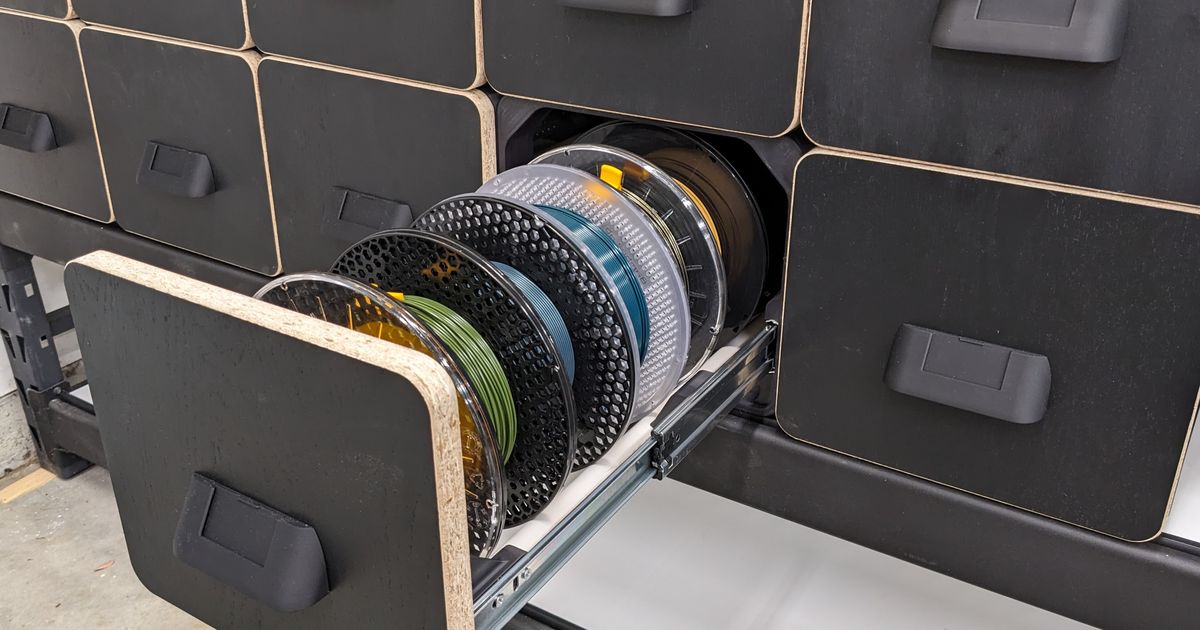Modular Filament Drawer System
Modular Filament Drawer System
Print Profile(0)
Description
Moved from printables to here so more people can have access to this awesome design. I did make a couple changes to some of the holes I found too lose or too tight.
I have 8 of these setup and holds 72 rolls of filament 9 each. Absolutely amazing space savings.
Intro
This is a modular drawer for filament storage. Each unit can be stacked vertically and horizontally. The depth is determined by the size of drawer slides used. Check below for the list of fasteners and drawer slides that work with this design. The system uses two frame pieces attached to the drawer slides for the frame. For the drawer, it requires a front, a rear, middle supports and ½" PVC pipes attached to the drawer slides. The length of the PVC is the same as the drawer slides. For instance, if using a 24" drawer slide, you would cut your PVC to 24".
Faceplates and Drawer Pulls
For faceplates, there are two options. The ‘lite’ version is designed to attach a full faceplate (I'm using some finished plywood, MDF or similar would work great). There's also a standard faceplate which is just 2/3rd height, and doesn't require an additional wood faceplate. You could also 3d print a faceplate to attach to either. The spacing for a drawer pull is 3" if you don't want to use the included 3d printed drawer pull. The included drawer pull accepts a 1" x 2" label, which is a common size. You can buy pre-cut labels or make your own.
Printing
All 3d printed parts should be printed out of ABS or ASA or any material that's both strong and not prone to creep. PLA will eventually sag and deform under load. It's not recommended. PETG is way too flexible and will buckle under the load of the filament. The frames are larger than a typical build volume, but should work on medium or larger format printers. They are too large for a Bambu X1C or Prusa MK3/4. Standard settings are fine, no supports are needed and 0.2mm layer height is fine.
Parts List
Here is a list of some of the parts necessary. Some of the links are affiliate links, but you can source your own if you want!
- ½" PVC Pipe (the design is made for schedule 40, commonly found at every hardware store)
- Lontan Drawer Slides
- #6 3/8" wood screws (for attaching drawer slides, 8 per module)
- #6 5/8" wood screws (for connecting modules, faceplates, middle supports. 20 required per module, additional for connecting modules together)
- ½" Cabinet Door Bumpers (3.5mm tall, 2 per module)
Wood screws work, but you could also use thread-forming screws made for plastic. Be careful when adding fasteners, go slow and limit your torque or you could split the 3d printed parts.
Connecting and Securing
Multiple modules can be stacked vertically or horizontally. I probably wouldn't stack more than 3 high, but you can go as wide as you want. Securing the modules together makes them MUCH sturdier. There are two holes on each edge of each frame. They are designed so one edge is a through-hole and the corresponding hole is smaller for self-tapping. There are also recesses on the top and bottom of each frame. These are for silicone bumpers which act as a keying feature for stacking or for placing on a shelf.
The modules will need to be secured down to the surface, or else they could tip when extending the drawers! If you have sufficient modules connected together, it might be stable enough without securing it down to a surface, but it's still recommended.
Assembly Notes
When assembling the frames, keep the indent for the drawer slides facing forward. The area that's flush should be facing backwards. This will keep the holes for connecting multiple modules together aligned.
When assembling the drawers, press-fit the front and rear 3d printed pieces to your PVC pipes. Lay on a flat surface to make sure everything is flat before adding the bottom fasteners. Then add the middle supports and side rails for the drawer slides. Before securing the middle supports, make sure the drawer slides are parallel to each other and squared, then secure everything by screwing through the bottom hole on the middle supports into the PVC.
Always be careful with self-tapping screws into plastic. Go slow, maybe use some WD-40 or wax. If you're using a driver, make sure it's on the slower speed and has the clutch engaged, so you don't overtighten. This may slit the parts. Nothing needs to be tightened excessively, the design will keep everything aligned and tight.
Each module should use less than 500g of filament, meaning a 1kg roll can make 2 modules.






